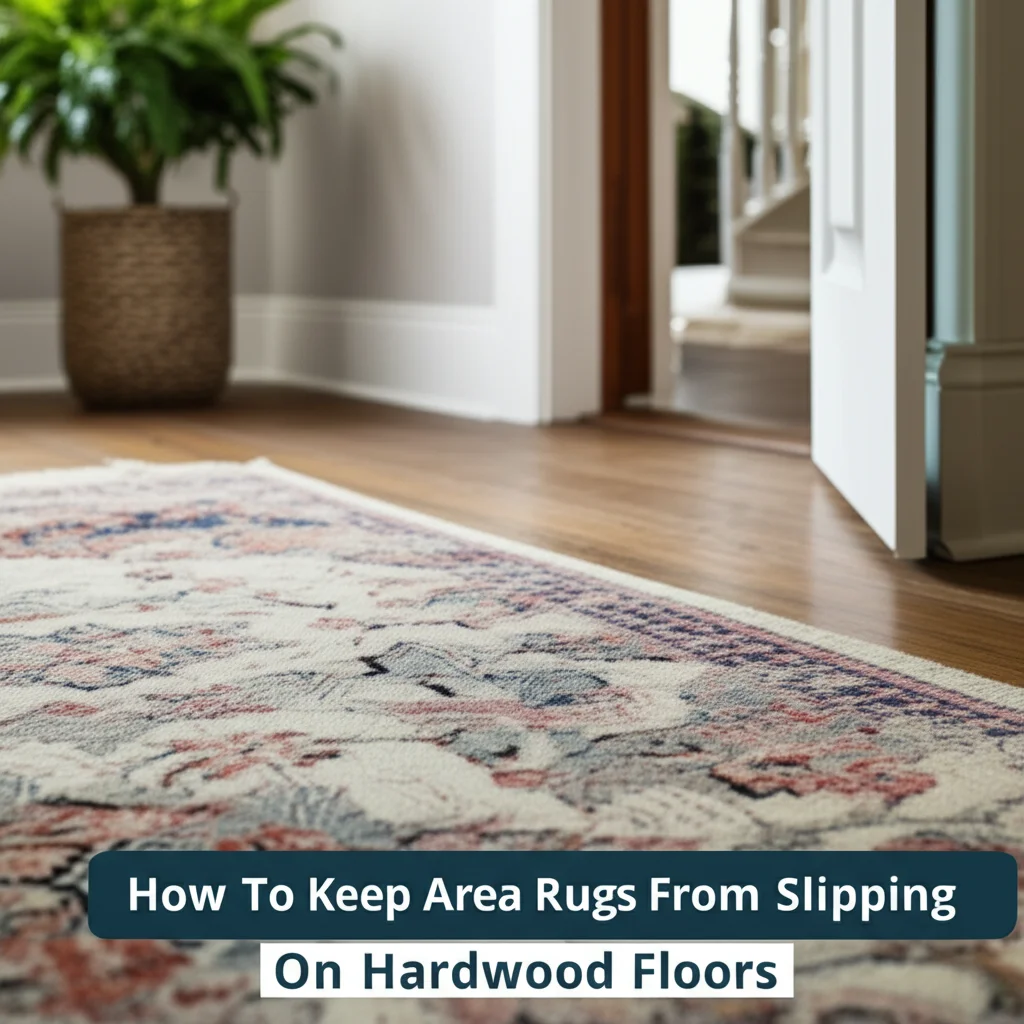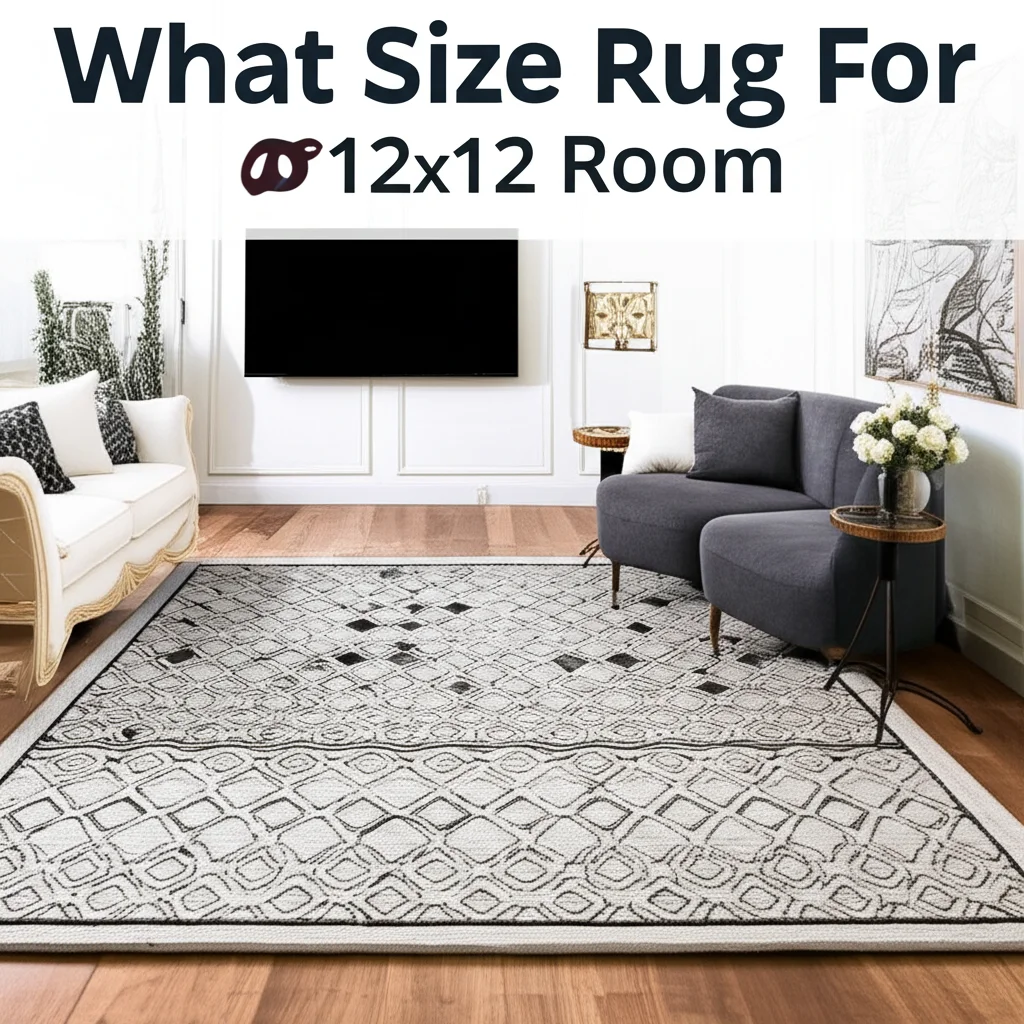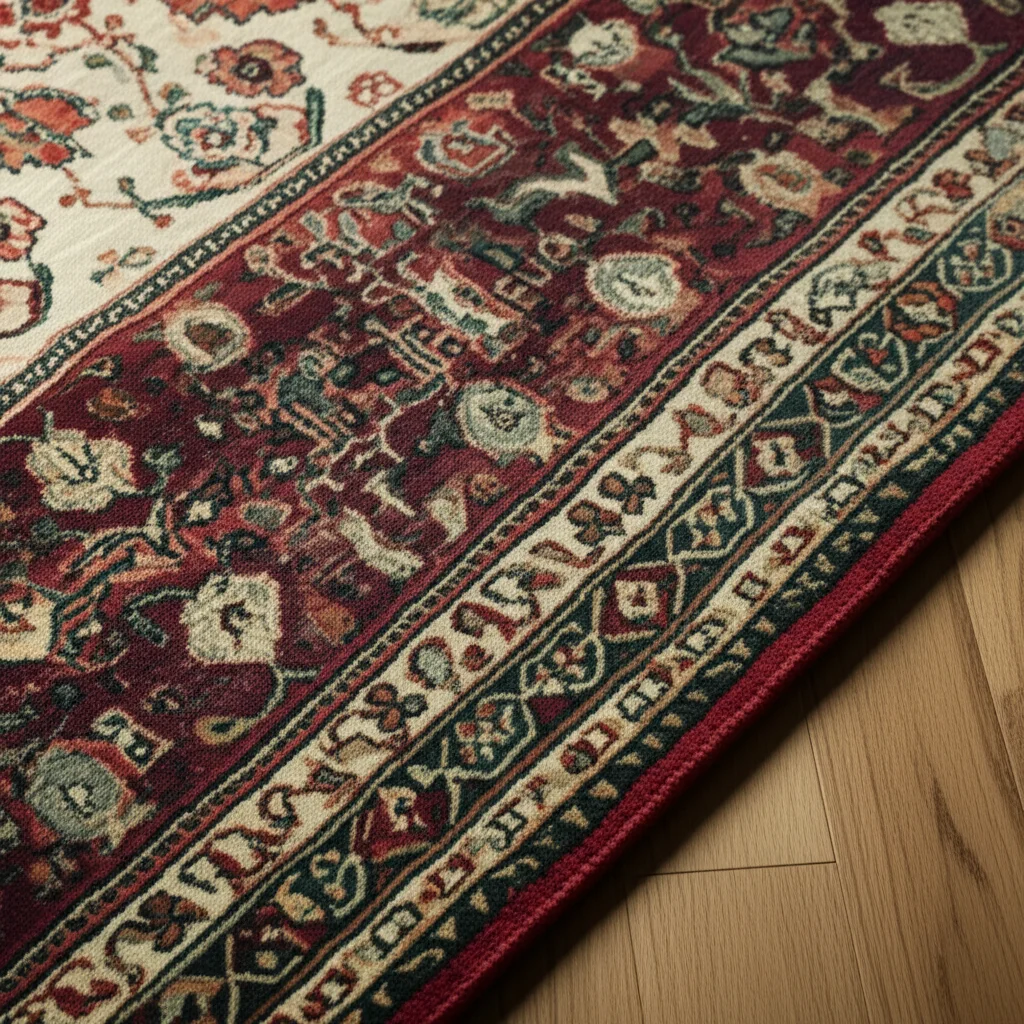· Todd Martin · Home Improvement · 12 min read
How To Keep Area Rugs From Slipping On Hardwood Floors

9 Proven Ways to Keep Area Rugs From Slipping on Hardwood Floors
Few things are more annoying (or potentially dangerous) than area rugs that won’t stay put on hardwood floors. That telltale bunching at the edges or the sudden slip when you step onto your beautiful rug can turn an elegant home accent into a genuine hazard. If you’re constantly straightening your rugs or have experienced near-falls due to sliding rugs, you’re not alone.
Area rugs sliding on hardwood floors is one of the most common household complaints, but thankfully, there are numerous effective solutions to this problem. This comprehensive guide will walk you through everything you need to know about how to keep area rugs from slipping on hardwood floors.
Quick Takeaway:
- Use proper rug pads specifically designed for hardwood floors
- Apply rug grippers or tape for targeted slip prevention
- Choose rugs with natural rubber backing for built-in stability
- DIY solutions like silicone caulk can work for budget-conscious homeowners
- Regular maintenance of both rugs and floors helps prevent slipping
Area rugs can be secured on hardwood floors using specialized rug pads, double-sided tape, silicone caulk beads, carpet tape, or furniture anchoring. The best method depends on your rug size, floor finish, and whether you need a permanent or temporary solution.
Why Do Rugs Slip on Hardwood Floors?
Before diving into solutions, it’s helpful to understand why area rugs tend to slip on hardwood surfaces in the first place. Hardwood floors, while beautiful, create the perfect conditions for rug movement due to their smooth, polished surface.
The Physics Behind Slipping Rugs
The issue comes down to basic physics—specifically, friction (or the lack thereof). Hardwood floors have a smooth, sometimes glossy finish that creates minimal friction with rug materials. When you add normal household activities like walking, vacuuming, or pets running around, these movements easily overcome the minimal friction between the rug and floor, causing slippage.
Several factors contribute to this problem:
- Smooth floor finishes: The more polished your hardwood floor, the less natural grip it provides
- Lightweight rugs: Thinner, lighter rugs have less mass to help them stay in place
- Synthetic rug materials: Some synthetic fibers are inherently more slippery than natural materials
- High traffic areas: More movement across the rug means more opportunities for shifting
- Humidity and temperature changes: These can affect both the rug and floor materials, altering how they interact
Understanding these factors will help you choose the most effective solution for your specific situation. For instance, a lightweight rug in a high-traffic hallway will need different anti-slip measures than a heavier rug in a rarely-used guest room.
Best Non-Slip Rug Pads for Hardwood Floors
Perhaps the most popular and effective solution for keeping area rugs in place is using a quality non-slip rug pad. These pads sit between your rug and hardwood floor, providing the friction that’s naturally missing in this combination.
What Makes a Good Rug Pad for Hardwood Floors?
Not all rug pads are created equal, especially when it comes to use on hardwood floors. Here’s what to look for:
- Natural rubber backing: Provides excellent grip without damaging floor finishes
- Felt top layer: Adds cushioning and protects both the rug and floor
- Proper thickness: Typically 1/8” to 1/4” thick—enough for grip without creating a tripping hazard
- Breathable materials: Allows air circulation to prevent floor damage from trapped moisture
- Appropriate size: Should be 1-2 inches smaller than your rug on all sides to remain hidden
Top Rug Pad Recommendations
Based on consumer reviews and expert testing, these rug pads deliver excellent performance on hardwood floors:
- Felt and rubber combination pads - These dual-purpose pads provide both cushioning and grip
- Natural rubber mesh pads - Excellent for pure non-slip functionality in low-profile applications
- PVC-free options - Avoid potential chemical reactions with floor finishes
When shopping for a rug pad, avoid products made with PVC, adhesives, or synthetic rubber compounds, as these can potentially damage or discolor hardwood floor finishes over time. Instead, look for terms like “natural rubber,” “felt,” and “safe for hardwood floors” on the packaging.
For more information on selecting the right rug pad for different floor types, check out our guide on what rugs are safe for hardwood floors.
Rug Grippers and Tape Solutions
If you prefer a more targeted approach than full rug pads, various gripper and tape products can effectively keep your area rugs in place.
Double-Sided Rug Tape
Double-sided rug tape is an affordable, easy-to-apply solution that works well for smaller rugs or runners. The best versions feature:
- Residue-free adhesive that won’t damage your floors when removed
- Strong holding power to prevent slipping even in high-traffic areas
- Easy application and removal for seasonal rug changes
To apply double-sided rug tape:
- Clean both your floor and the underside of your rug
- Apply tape strips in a grid pattern on the rug’s underside, focusing on corners and edges
- Remove the protective backing and firmly press the rug onto the floor
Silicone Rug Grippers
Silicone-based rug grippers offer excellent grip without adhesives. These typically come as:
- Corner grippers that attach to the underside of rug corners
- Strip grippers that can be cut to size for custom applications
- Washable and reusable options for long-term use
Silicone grippers work through friction rather than adhesion, making them ideal for expensive hardwood floors where you want to avoid any risk of residue or damage. Learn more about silicone options in our article about silicone rug tape for hardwood floors.
DIY Methods to Prevent Rug Slipping
If you’re looking for budget-friendly or immediate solutions using items you might already have at home, several DIY methods can be surprisingly effective.
Silicone Caulk Method
This ingenious hack creates a custom non-slip backing:
- Flip your rug upside down on a protected surface
- Apply small dots or lines of clear silicone caulk to the rug backing in a grid pattern
- Allow to dry completely (usually 24-48 hours)
- The dried silicone creates friction points that grip the floor
This method works particularly well for lightweight rugs and can last for years before needing reapplication.
Hot Glue Grip Lines
Similar to the silicone caulk method, hot glue can create non-slip friction points:
- Using a low-temperature hot glue gun, apply thin lines of glue to the rug backing
- Create a grid pattern, focusing on edges and corners
- Allow to cool completely before placing on your floor
Shelf Liner Cut-to-Size
Non-adhesive rubber shelf liner can be cut to the dimensions of your rug to create an impromptu rug pad:
- Purchase non-adhesive, rubber shelf liner (available at most home goods stores)
- Cut it approximately 1-2 inches smaller than your rug on all sides
- Place between your rug and hardwood floor
While not as durable as commercial rug pads, this solution works well as a temporary fix or for rarely moved rugs.
For more DIY solutions, visit our guide on how to stop rug from sliding on wood floor DIY.
Choosing Rugs That Stay Put Naturally
If you’re in the market for new area rugs, selecting ones with inherent non-slip properties can significantly reduce sliding issues before they begin.
Rug Materials That Grip Better
Some rug materials naturally provide better grip on hardwood surfaces:
- Wool rugs: The natural fibers create more friction than many synthetics
- Cotton rugs: Often heavier and less prone to sliding
- Rugs with natural rubber backing: Built-in non-slip properties
- Heavier rugs: Greater weight helps keep them in position
Rug Construction Features That Help
Beyond materials, look for construction details that enhance stability:
- Higher pile height: Creates more surface area in contact with the floor
- Textured backing: Some rugs feature woven textures that increase friction
- Reinforced edges: Prevents curling, which often initiates slipping
When shopping for a new area rug for hardwood floors, don’t hesitate to ask specifically about non-slip qualities and whether the rug will require additional stabilization measures. For more guidance on selecting ideal rugs for hardwood surfaces, read our article on what kind of rugs are safe for hardwood floors.
Furniture Placement Strategies
Strategic furniture placement can help anchor rugs without additional products, especially for larger area rugs.
Using Furniture to Secure Rugs
When arranging your furniture, consider these approaches:
- Place heavier furniture pieces partially on the rug: Sofas, coffee tables, and entertainment centers can anchor the edges
- Ensure balanced coverage: Distribute furniture weight evenly across the rug when possible
- Create “zones” with your rug: Position furniture to create natural boundaries that limit rug movement
For open concept spaces or minimal furniture arrangements, aim to have at least the front legs of major furniture pieces on the rug to provide anchoring weight.
Optimal Rug Sizing for Stability
Selecting the right size rug for your space also impacts stability:
- Living rooms: Ideally, all furniture should have at least front legs on the rug
- Dining areas: The rug should extend at least 24” beyond the table on all sides
- Bedrooms: Either place a large rug under the entire bed or use smaller rugs at the sides
Properly sized rugs not only look more intentional in your design but also stay in place better as they have less room to shift and are more likely to be anchored by furniture.
Maintaining Your Non-Slip Solutions
Once you’ve implemented solutions to keep your area rugs from slipping, proper maintenance will ensure continued effectiveness.
Regular Cleaning Practices
Both your floors and rug backing need regular attention:
- Vacuum the underside of rugs: Dust and debris can reduce the effectiveness of non-slip backings
- Clean hardwood floors regularly: Remove dust that might create a slippery surface
- Wash and replace rug pads: Follow manufacturer recommendations for cleaning or replacement
For specific cleaning methods for different rug types, see our guide on how to shampoo area rugs on hardwood floors.
When to Replace Non-Slip Products
Even the best non-slip solutions don’t last forever. Watch for these signs that it’s time for replacement:
- Visible deterioration of rug pad material
- Reduced effectiveness despite cleaning
- Curling or bunching of the pad itself
- Discoloration that might indicate breakdown of materials
Most quality rug pads will last 3-5 years before needing replacement, while temporary solutions like tape may need more frequent attention.
Special Considerations for Different Spaces
Different areas of your home may require tailored approaches to keep rugs secure on hardwood floors.
High-Traffic Areas
For entryways, hallways, and other high-traffic zones:
- Use heavier-duty rug pads with excellent grip
- Consider washable options for areas that require frequent cleaning
- Reinforce corners where movement typically begins
Runners in hallways are particularly prone to shifting and may benefit from combination approaches, such as a quality pad plus corner grippers.
Areas With Pets or Children
Homes with active pets or children present unique challenges:
- Choose machine-washable solutions for inevitable accidents
- Opt for non-toxic materials safe for curious pets and crawling babies
- Install more robust anchoring to withstand running and play
For additional tips on maintaining rugs in pet-friendly homes, check out our article on how to keep dogs from peeing on rugs.
Special Flooring Types
While this article focuses on hardwood floors, similar principles apply to other smooth flooring:
- Laminate flooring: Also slippery, but sometimes more sensitive to adhesives
- Tile floors: Often have grout lines that help limit movement but may still benefit from rug pads
For specific advice on laminate surfaces, see how to keep rugs from slipping on laminate floors, and for tile floors, visit how to keep rugs from slipping on tile.
Frequently Asked Questions
How do I stop a rug from sliding on a wood floor?
The most effective methods include using a proper non-slip rug pad made of natural rubber and felt, applying double-sided rug tape designed for hardwood, using silicone rug grippers, or creating friction with DIY solutions like silicone caulk dots. The best approach depends on your rug size, floor finish, and whether you need a temporary or permanent solution.
What household items can I use to keep my rug from slipping?
Common household items that can prevent rug slipping include hot glue (applied in a grid pattern to the rug backing), non-adhesive shelf liner cut to size, silicone caulk applied in dots, and even heavy furniture placement to anchor larger rugs. These DIY solutions work well for immediate needs when commercial products aren’t available.
Will rug tape damage my hardwood floors?
Quality rug tape designed specifically for hardwood floors should not damage the finish when used correctly. Look for products labeled “residue-free” and “safe for hardwood.” Avoid traditional carpet tapes or those containing strong adhesives. Always test in an inconspicuous area first and remove according to manufacturer instructions.
How often should I replace my rug pad?
Most quality rug pads should be replaced every 3-5 years, depending on traffic and use. Signs it’s time for replacement include visible deterioration, reduced effectiveness, discoloration, or hardening of the material. Washing according to manufacturer instructions can extend the life of many rug pads.
Can I use the same methods for keeping outdoor rugs from moving?
While similar principles apply, outdoor conditions require specialized solutions. For securing outdoor rugs, see our guides on how to keep outdoor rugs from blowing away on concrete and how to keep an outdoor rug from blowing away.
Do heavier rugs still need non-slip solutions?
Yes, even heavier rugs can benefit from non-slip solutions, especially in high-traffic areas or homes with active children and pets. While weight helps, the smooth surface of hardwood still allows movement. At minimum, corner grippers can prevent edge curling and initial movement that leads to shifting.
How can I make my bathroom rugs stay in place?
Bathroom rugs present unique challenges due to moisture and frequent movement. For bathroom-specific solutions, read our article on how to keep bathroom rugs from sliding.
Final Thoughts: Safe and Secure Area Rugs Enhance Your Home
Learning how to keep area rugs from slipping on hardwood floors not only eliminates a common household frustration but also significantly improves safety for everyone in your home. From proper rug pads to creative DIY solutions, the methods outlined in this guide provide options for every budget and preference.
Remember that the best approach often combines multiple techniques—perhaps a quality rug pad for larger rugs with additional corner grippers in high-traffic areas. Regular maintenance of both your rugs and floors will extend the life of your non-slip solutions while protecting your beautiful hardwood surfaces.
By taking the time to properly secure your area rugs, you transform them from potential hazards into the safe, beautiful design elements they’re meant to be—adding warmth, color, and texture to your hardwood floors without the worry of dangerous slips or constant straightening.
Ready to explore more floor covering solutions? Discover how to protect wood floors with area rugs for additional tips on creating a beautiful, functional, and safe home environment.




